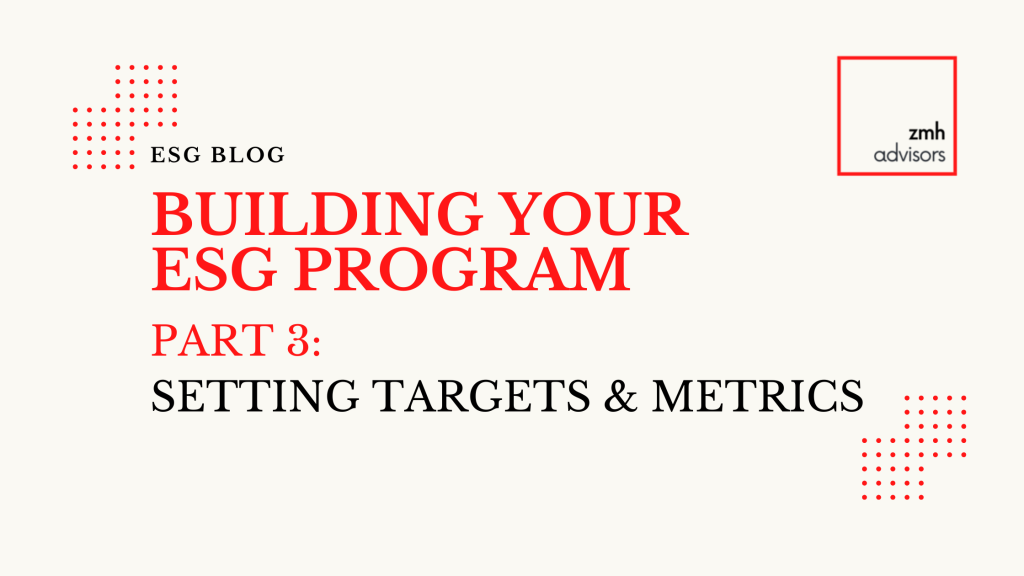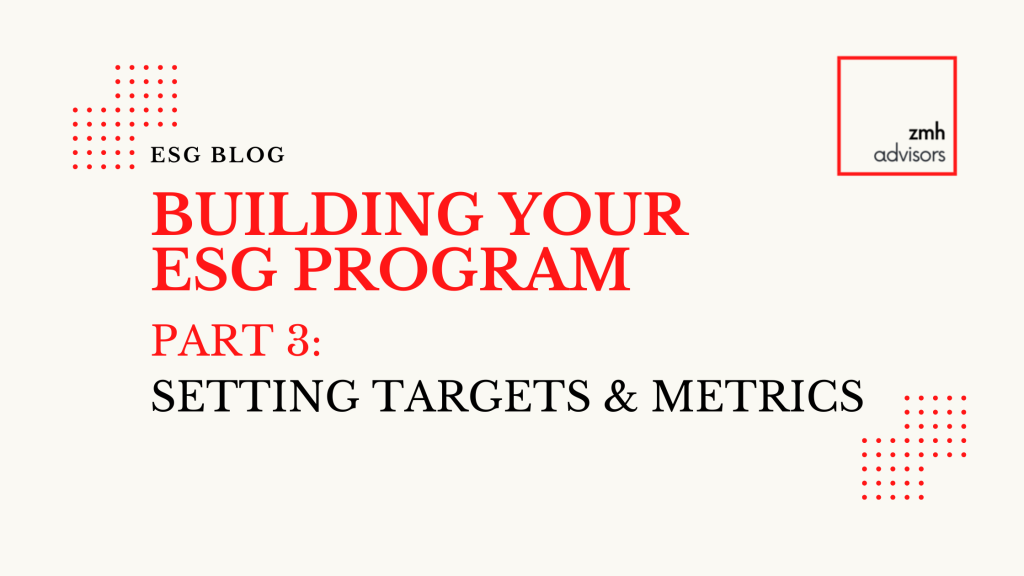Setting Targets & Metrics
After you assemble your team to help build your ESG program and your company comes up with an ESG strategy, you’ll need to establish a framework to execute that strategy. An important part of this step is knowing what to consider in your target-setting process. This will enable you to cover all bases when choosing the right metrics to track your progress.
In selecting your targets – if you’re a public company – it’s helpful to know what the SEC has proposed as future disclosure requirements for Green House Gas (GHG) emissions. Companies shouldn’t be limited to the SEC’s mandated disclosures (when finalized), as there are demands from other key stakeholders beyond regulators to consider. But knowing what the SEC has proposed is as you begin to think about metric and target tracking, is a good place to start.
Under the SEC’s proposal, companies would be required to disclose the baseline year for their GHG emission targets – and that baseline year would need to be consistent for all targets designated by each company. Many companies set near-term, medium-term and perhaps even longer-term targets. For those companies with overlapping commitments targets – such as a goal of net zero GHG emissions by 2050 pursuant to the Paris Agreement, or a plan to cut Scope 1 and 2 emissions by 50% by 2030 and reduce Scope 3 emissions by 35% by 2030 – they would be required to disclose all of those targets.
Other elements of the SEC’s climate disclosure proposal would require reporting on:
- The scope of activities and emissions included in the target;
- The unit of measurement, including whether the target is absolute or intensity-based;
- The defined time horizon by which the target is intended to be achieved, and whether the time horizon is consistent with one or more goals established by a climate-related treaty, law, regulation, policy, or organization;
- The defined baseline time period and baseline emissions against which progress will be tracked with a consistent base year set for multiple targets;
- Any interim targets set by the company;
- How the company intends to meet its climate-related targets or goals;
- If a company uses carbon offsets or Renewable Energy Credits (REC) in its plan to meet targets and goals, there would need to be disclosure about the amount of carbon reduction represented, the source of the offsets or RECs, a description and location of the underlying projects and the cost of the offsets or RECs; and
- Whether – and how – the board sets climate-related targets or goals and how it oversees progress against those targets or goals, including the establishment of any interim targets or goals.
Beyond the SEC’s proposal, you should keep abreast of other industry standards and frameworks, including:
- Regulators – The International Sustainability Standards Board (ISSB) is a standard-setting body established in 2021 under the direction of the IFRS Foundation, whose mandate is the creation and development of sustainability-related financial reporting standards to meet investor needs for sustainability reporting. The ISSB is expected to finalize a set of standards in 2023 and the SEC is expected to piggyback off the ISSB’s work.
- Rating Agencies – There are numerous rating agencies that investors use to help them determine whether to invest in your company and what level of commitment is appropriate. CDP and Dow Jones Sustainability Indexes are organizations that rate companies only if the company completes their questionnaire. If their rating is important for your company, you will need to complete the survey. Others, such as MSCI, ISS ESG, ISS QualityScore, and Sustainalytics, create assessments of your company based on publicly available information.
- Institutional Investors – Institutional investors have their own investing guidelines, as well as voting policies. You’ll want to keep abreast of changes in stewardship & voting policies of the investors that are important to you. You also may receive requests for information from investor coalitions. It’s always in your best interest to talk to them, as it may head off a shareholder proposal down the road.
- Industry Trends & Peers – You’ll want to participate in forums within your industry to keep abreast of what is being discussed about trends that impact your industry. You’ll want to read the disclosures made by peer companies to ascertain what their goals and metrics are – and how they’re progressing.
The bottom line is that when deciding which metrics and targets to use, you’ll need to consider what type of information you’ll be required to – and want to – publicly disclose. The concept of “materiality” plays into that and we’ll dig into that complex concept in our next blog.
How ZMH can help: We can help you to tackle this three-step process. ZMH offers a low cost, turn-key solution with an approach that focuses on:
- Mapping your company’s current ESG profile against the SEC’s baseline disclosure requirements to identify potential gaps (our “Baseline Assessment”);
- Identifying what should be your company’s appropriate internal resources and expertise with the goal of addressing any gaps in disclosure that are identified;
- Helping to develop your TCFD, Scope 1 and 2 and other disclosures to assist in meeting the SEC’s minimum expected disclosure requirement.
Renewable Energy Credit – a tradeable, market-based instrument that represents the legal property rights to the “renewable-ness”—or non-power (i.e., environmental) attributes—of renewable electricity generation. (Source link)


